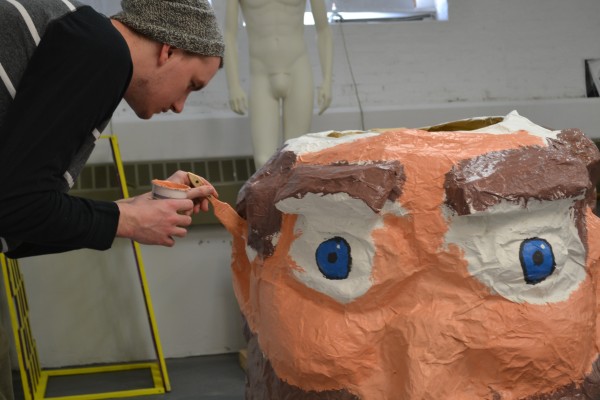
[Editor’s Note: The Farmington send-off will be held at 9 a.m., rather than 10 a.m.]
FARMINGTON – A giant ax sat next to a giant chainsaw waiting for its orange wet paint to dry.
Across the studio, a giant, block-shaped head had flesh-colored paint applied around its beard and hair. Out in the hall a moose was undergoing antler construction.
The sculptural work going on in the basement of Merrill Hall on the first warming Saturday anybody can remember is only one piece of a unique interdisciplinary course titled Re-Thinking Paul Bunyan at the University of Maine at Farmington.
Fourteen upper level students from a variety of majors are working with three faculty members and a local puppet artist in this pilot course that combines the disciplines of anthropology, history, art and performance in the study of origins, myths and folklore.
Paul Bunyan is one popular folklore giant in the U.S. and eastern region of Canada. Many towns like Bangor have claimed the larger-than-life lumberjack in one form or another as their own. Fantastic tales of the hard-working logger and brave frontiersman grew to cultural iconic status at the turn of the 20th century, thanks to the news media and a public ready to embrace a legend of such heroic proportion.
The UMF students and their instructors Gaelyn Aguilar, assistant professor of anthropology; Gustavo Aguilar, assistant professor of experimental performance; Jesse Potts, assistant professor of Art and Michael Romanyshyn, puppet master of Temple Steam Theater, have employed a variety of methods to explore myth starters, discuss “ideological signs of nation-state and borders as frontiers of identity and the friction of global social interaction—all through the lens of the legendary logger,” said Gaelyn Aguilar.
Student field work has included a discussion with Peggy Yocom, a folklorist specialist and Rangeley Lakes Region Logging Museum curator who teaches in the Department of English at George Mason University in Fairfax, Virginia.

Logger Lance White of Dixfield offered a cutting lesson in the woods, consulting forester Steve Gettle of Jay gave a silviculture overview and Barry Dana, a former chief of the Penobscot Nation, gave his cultural perspective. Susan Gagnon, filmmaker of The River’s Edge, which told of the generations of the paper industry’s workers of Jay and Livermore Falls, offered a history lesson, as did Clint Bruce, an assistant French language professor who spoke of Maine’s Acadian heritage.
All this expertise provided precious background, along with the course’s required readings, prepared the Re-Thinking Paul Bunyan class to do just that. The plan for the grand finale class project is on April 19 to bring the Bunyan-inspired sculptural pieces they created to the U.S. Canada border crossing at Coburn Gore. Once there, the class as a parade of Bunyan puppet parts will cross the border into Canada to conceptually “return Paul to his French-Canadian roots,” Gaelyn Aguilar said and to symbolize Bunyan’s freedom from any one myth.
Concordia University students from Montreal will be greeting the American counterparts on the other side of the border. The U.S and Canadian border officials have been notified and a police escort to the border has been offered. The public is invited to attend the event. A send off from UMF is scheduled for 9 a.m. Saturday, April 19 for a border crossing at about noon.
“We’ll be liberating Paul Bunyan in a poetic gesture,” added Gustavo Aguilar.
History and political science senior, Ryan Sucy likes the multimedia collaborative classwork he’s been assigned.
“It’s taken a bunch of different subjects and put it all together,” he said. “I liked the idea that’s an out-of-the-box kind if thing.” Sucy of Oakland, grew up in Maine.
“I heard all the stories, but looking at it all now, the logging, nature, history, you get a better picture of all the little things, the details,” he said, as he put the finishing touches on Bunyan’s face.






That should be a hoot, lets hope parties on both sides of the line can pull it off
My Grand Dad, Al Davis, was an old lumber crew boss from N.S. who followed the cutting down through Maine and south taking time out to marry my Grand Mother in Fryeburg